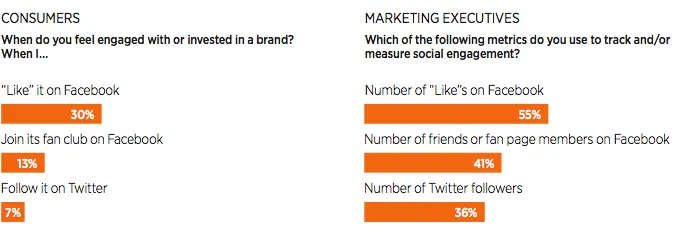Why Measuring the Number of Followers is a Bad Idea
by Member of TrueSocialMetrics team ~ 4 min
Why does everyone consider the number of followers a valuable metric? Because they think that:
Followers are your loyal customers and will buy your product.
Barely.
People can put a like on your Facebook page or follow you on Twitter and the next second not even remember doing so. This is due to the factors described in the next paragraph.
Followers are the number of people who will see your posts.
Maybe.
How about Edgerank, or different time zones users live in, or what if they are following several dozens or even hundreds of people? Do you still think they will see your posts? This doesn’t even consider the level of their activity in social networks - maybe they visit once a month or forgot about their account a year ago. And what about bots and fake accounts?
The followers of your followers will also see your posts if liked or shared with them by your followers.
Very unlikely.
If even your own followers are not necessarily seeing your posts what is the chance of their followers seeing it? But if a miracle happens and your posts were shared or liked or commented on and your followers’ followers could possibly see them? Maybe what we should measure are these productive actions (likes, shares) and not the raw number of followers?
Do you still think the number of followers is a metric you should be crazy about? Instead of that, it is more logical to measure followers activity; their engagement each time you post. And that's where Avinash Kaushik’s The Super Four comes on stage: Amplification rate, Conversation rate, Applause rate and Economic value.
- Applause rate - number of likes on average per 1 post in your account
- Amplification rate - number of shares on average per 1 post in your account
- Conversation rate - number of comments on average per 1 post in your account
- Economic value - how much monetary value users coming from each social network bring you
In other words, The Super Four show you how much response/reaction/feedback from your followers you managed to get on your posts. The users that react are the ones who definitely see your posts, can become loyal to your brand, more likely to tell their friends about it and could even buy your products. Isn’t that what you were looking for in the first place?
Of course, the number of followers should somehow matter, but it is wiser to measure this figure in conjunction with other metrics to make it insightful. For example, I measure [Relative Metrics](< /support/how-to-interpret-results#relative-metrics>). It is simply metrics averaged by the number of followers showing the metric per one follower: Applause per one follower, Amplification rate per one follower, and Conversation rate per one follower. Why do I do this? Because, you know, having 20 likes per post with 200 followers is super awesome but having the same 20 likes per post with 2 million followers is a bit alarming. Either your posts suck or you have lots of “zombie” followers (bots, inactive, etc.) On top of that, with such relative numbers you can easily compare your results with your competitors’, not biased by the number of followers.
Have you ever heard about advertising blindness - when people get so tired of omnipresent annoying ads they became immune to them and their perception automatically filters that ad noise. And the more ads we have the harder it is to break through this barrier of perception. Did your posts succeed in this task? Maybe or maybe not. Now you can measure it.
Update: Some convincing stats - the difference between what users perceive as an engagement and what marketers measure:
Social engagement. Report “ForbesInsights - “The new rules of engagement. Measuring the power of social currency”.
Obviously, followers are totally overvalued.
When you’re ready to rock your social media analytics
give TrueSocialMetrics a try!
Start Trial
No credit card required.





